|
Date written: 2024-08-30 / Author: spaztron64
|
|
This article will go more in depth on the technical details and model/generation specific quirks across the PC-9800 lineup.
Partial and complete incompatibles like the hi-reso machines and the early portables (PC-98HA, PC-98LT) will not be covered.
|
|
The specifications described below are available across every official PC-9800 and compatible clone system:
- Use of an x86 processor, with full backwards compatibility back to the Intel 8086.
- Startup in Real Mode, providing a 1MB address space split into segments on a 20-bit address bus.
- A full 16-bit data bus between the processor and add-in boards, inserted into the officially dubbed "C-Bus" expansion slots.
- A full 16-bit I/O port address range.
- At least one floppy drive interface.
- Two uPD7220 (Graphics Display Processor, or GDC) video controllers, one for text generation and another for bitmap drawing, chained in a master/slave configuration where text is overlaid on top of the bitmap, and each with their own VRAM pool.
- The text GDC has at least 8KB of RAM and the graphics GDC at least 96KB.
- A pair of high resolution and low resolution character sets compliant with the JIS X 0201 standard.
- The possibility of adding, if not already built-in, an additional character ROM to supplement the high resolution character set with a double-byte encoded Kanji glyph set.
- The following display modes: 640x200/2 colors/6 pages, 640x200/8 colors/2 pages, 640x400/2 colors/3 pages, 640x400/8 colors/1 page
- A horizontal scan rate (HSync) of 24kHz, and a vertical scan rate (VSync) of 56.6Hz.
- A built-in beeper speaker or a passthrough of it's signal to a dedicated sound board.
|
|
The 1st generation of systems spans a release period between late 1982 and mid 1985, consisting of the original PC-9801 and it's derivatives: PC-9801E, PC-9801F, PC-9801M.
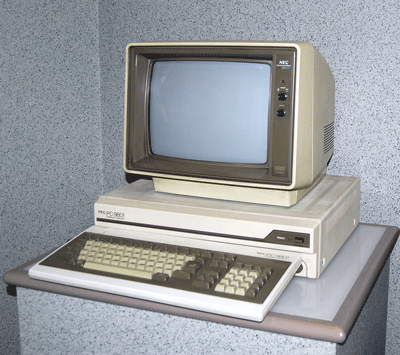
The original PC-9801, paired with it's standard keyboard and display
The technical specifications are as follows:
| Processor: |
Intel 8086 (5MHz on original model, 8MHz on E/F/M) |
| Graphics: |
2x uPD7220, 640x200/2 colors/6 pages, 640x200/8 colors/2 pages, 640x400/2 colors/3 pages, 640x400/8 colors/1 page |
| Video output: |
Digital RGB. 15kHz (200 line modes only) or 24kHz (200 and 400 line modes) |
| Sound: |
Intel 8253A PIT-driven beeper |
| Memory: |
128KB standard, user expandable to 640KB |
| Expansion: |
C-Bus slots, between 2 and 6 depending on the model |
| Storage: |
External 320K/640K/1.2MB drives, or up to two internal 5.25" 640K drives |
Misc info:
- The 8253A PIT's 2nd counter is responsible for driving the DRAM refresh timings, unlike all later generations where it controls the beeper's playback frequency. As such, the frequency cannot be controlled.
- Due to the lack of 16 color graphics, 80186 instructions, and GRCG chipset out of the box, most games from 1985 onwards will not support these models
- Kanji support requires an additional C-Bus card with the appropriate character ROM
|
|
The 2nd generation of systems spans a release period between mid 1985 and early 1988, coexisting with the subsequent two generations.
The lineup consists of the PC-9801VF, PC-9801VM, PC-9801UV and their revisions.
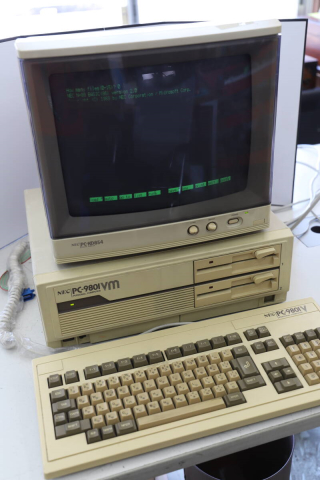
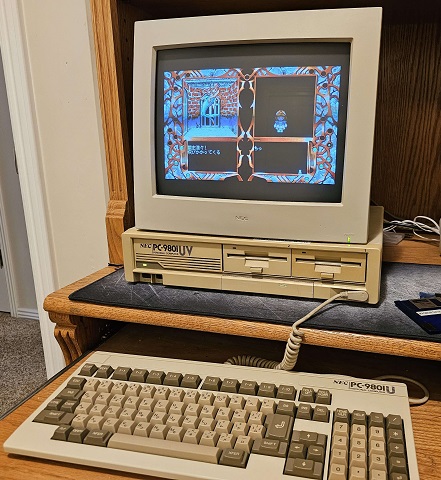
The PC-9801VM and PC-9801UV
The technical specifications are as follows:
| Processor: |
NEC V30 @ 8 or 10MHz |
| Graphics: |
2x uPD7220 + GRCG chipset, all previous video modes + up to 8 colors on screen from a total of 4096 at 640x400/2page or 640x200/2+2page. |
| Video output: |
Digital and analog RGB. 15kHz (200 line modes only) or 24kHz (200 and 400 line modes) |
| Sound: |
Intel 8253A PIT-driven beeper. Integrated YM2203 synthesizer available on the UV models |
| Memory: |
256-384KB standard, user expandable to 640KB |
| Expansion: |
C-Bus slots, between 2 and 4 depending on the model |
| Storage: |
External 320K/640K/1.2MB drives, or up to two internal 5.25" or 3.5" 640K drives. 20MB SASI hard drive available on the VM4 |
Misc info:
- The amount of color entries at once can be increased from 8 to 16 colors with the PC-9801-24 add-in board
- The baseline for a large percentage of games, even those that would only really run at full performance on a 286 or 386 based machine
|
|
The third generation of systems spans a release period between late 1986 and late 1990.
It is made up of the PC-9801VX, PC-9801UX, PC-9801RX, PC-9801EX, PC-9801DX, and their revisions.
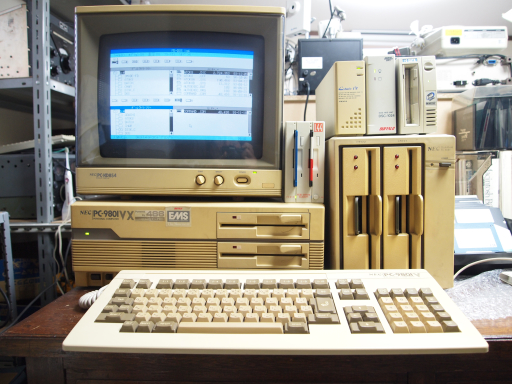
The PC-9801VX
The technical specifications are as follows:
| Processor: |
Switchable between the Intel 80286 @ 8-12MHz (depending on model) or the NEC V30 @ 8 or 10MHz |
| Graphics: |
2x uPD7220 + EGC chipset, all previous video modes + up to 16 colors on screen from a total of 4096 at 640x400/2page or 640x200/2+2page. |
| Video output: |
Digital and analog RGB. 15kHz (200 line modes only) or 24kHz (200 and 400 line modes) |
| Sound: |
Intel 8253A PIT-driven beeper. Integrated YM2203 synthesizer available on the UX, EX and DX models |
| Memory: |
640KB standard, user expandable up to 14.6MB depending on the model |
| Expansion: |
C-Bus slots, 3 or 4 depending on the model |
| Storage: |
External 320K/640K/1.2MB drives, or up to two internal 5.25" or 3.5" 1.2MB drives. Some models have a 20MB or 40MB SASI hard drive included. |
Misc info:
- This is the last time the graphics system would receive an upgrade, until the release of the 256-color PC-9821
- The original PC-9801-26 cannot be used with this or any later generation model, since the card doesn't have it's own clock crystal and relies on the computer to drive it's clock. The card will misbehave due to the faster CPU, so the improved PC-9801-26K must be used instead.
|
|
The fourth generation of systems marks the start of the 32-bit era and spans a release period between mid 1988 and mid 1992, though some would argue that extends to 1995.
The models include the PC-9801RA, PC-9801RS, PC-9801ES, PC-9801DA, PC-9801DS, PC-9801CS, PC-9801FA, PC-9801FX, PC-9801FS, PC-9801US, and their derivatives.
Some would also include the BA, BA2, BX, BX2, BS2, BA3 and BX3 from 1993-1995 but they're really just the budget alternative to the then new PC-9821 series, lacking 256 color modes.
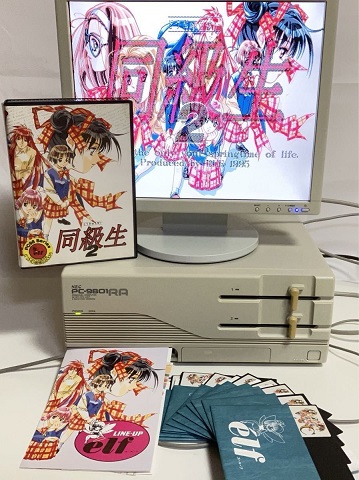
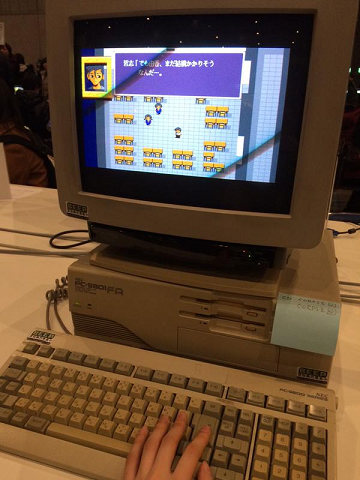
The PC-9801RA and PC-9801FA
The technical specifications are as follows:
| Processor: |
Various configurations of the 386DX, 386SX and 486SX with speeds between 16-20MHz. Some models still retain the switchable V30 @ 8 or 10MHz |
| Graphics: |
2x uPD7220 + EGC chipset, all previously defined video modes |
| Video output: |
Digital and analog RGB. 15kHz (200 line modes only) or 24kHz (200 and 400 line modes) |
| Sound: |
Intel 8253A PIT-driven beeper. Integrated YM2203 synthesizer available on the DA, DS, CS, FA, FX, FS, and US models |
| Memory: |
640KB or 1.6MB standard, user expandable up to 14.6MB depending on the model |
| Expansion: |
C-Bus slots, from 2 to 4 depending on the model. Some models have a file bay. |
| Storage: |
External 320K/640K/1.2MB drives, or up to two internal 5.25" or 3.5" 1.2MB drives. Some models have a 40MB or 100MB SCSI hard drive included. |
Misc info:
- The last generation of 16-color models predating the PC-9821 series.
- The oldest generation that officially supports the PC-9801-86 sound board.
- With the ability to use Virtual 8086 Mode comes support for XMS and emulated EMS memory managers, making dedicated EMS cards redundant.
- Certain games like Stormy Space, Atomic Punker, and the Touhou Project series cannot run on machines older than these. Even though they are Real Mode games, they still make use of instructions first introduced on the 386.
|
|
|


